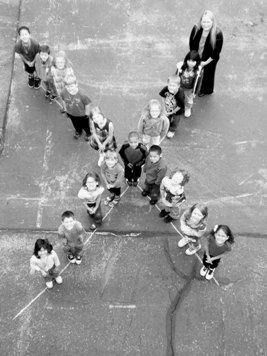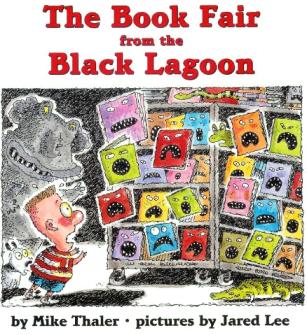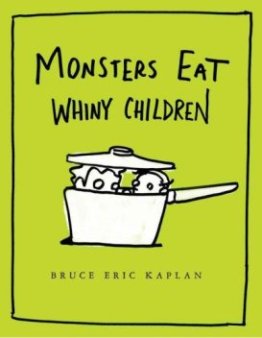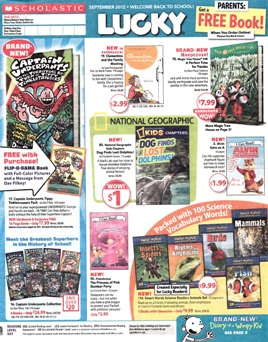Today, I have a special treat for you – the very first GUEST POST we’ve ever had at Building a Library. It was written by a dear friend, Megan McKnight, a lawyer and mom to two wonderful boys, who has been one of this blog’s biggest cheerleaders from day one. Megan actually sent me the bulk of this article in an email, asking me to give parents tips about picking titles from school book order catalogs. Her email was so full of her own great advice regarding book orders that I wrote her back and said, “Um, can I just post your email as an article? I’m never going to write anything better than what you just wrote.” And, after bugging her enough, she finally let me publish it (with a few edits and additions from her end). I love this article and think it’s a fantastic resource for any parent struggling with their monthly book order selections. Take it away, Megan!
*****
By Megan McKnight — I am a huge Building a Library fan. It is a great resource and stokes my enjoyment of reading children’s books. However, Building a Library does not help much with one of those familiar rites of the school year: BOOK ORDERS. We have been buying books from the Scholastic book order program for a few years and my track record is dubious at best. Distracted by the low prices and pretty pictures, I bought several awful books for my family. I recently recycled a stack of book order paperbacks — instead of donating them — because I do not want them to end up on another unsuspecting family’s bookshelf.
So, I developed my own set of Rules for use in ordering from the monthly book order that I follow to save my family from terrible books. Now, my family actually enjoys the books we order. My Book Order Rules are the following, in no particular order:
DO NOT BUY…
1. Books that do not list an author and illustrator. If no one has the pride to acknowledge writing or illustrating the book, it is not worth reading.
2. Books based on television, movie, or toy characters. Usually, these books are also eliminated by Rule #1. This rule is inapplicable if the book preceded the show. Olivia by Ian Falconer is a good example of this – my boys love this book!
3. Books with the exclusive purpose of teaching manners and improving behavior. Instead of making your child more patient and kind, these books will probably leave you and your child annoyed and bored. There are a few entertaining books intended to reinforce good behavior — seek these outside of the book order. For example, we enjoy these books: Do Unto Otters: A Book About Manners by Laurie Keller, Monsters Eat Whiny Children by Bruce Eric Kaplan, and Potty Animals: What to Know When You’ve Got to Go by Hope Vestergaard.
4. Book collections centered on the same character(s). For example, if you and your kids love Llama Llama Red Pajama by Anna Dewdney, you do not need three more Llama books. Chances are that you will get Llama-ed out, very quickly, and it may sap some of the magic from that first book, too. Instead, use the book order as a chance to expand your horizons. However, see Rule #12 below for a very important exception.
5. Books accompanied by a CD or DVD. The usual running time is 3 1/2 minutes per book, which is hardly worth the trouble of getting it set-up. Just sit down and read to your child for three minutes.
6. Books in hardcover. These are usually more than $10, and it is not worth paying more than $10 for any book from the book order, given the remote likelihood that the books will impress both you and your kid. If the book is good, it will be published in paperback soon..
7. Book collections that are exclusively seasonal. For example, “Books About Fall” or “Books About Easter.” For some reason, these are generally terrible and you will have squandered another opportunity to read an amazing story.
8. Non-books like games, shoe-tying activities, puzzles, toys and chore-charts. I have bought them all and the quality is universally poor.
9. Books that are accompanied by an accessory such as a car, a rock, a necklace, or 3-D glasses. The accessory is always of poor quality and the book rarely stands on its own.
BE WARY OF…
10. Books that are described as being written or illustrated by a “Caldecott Honor Artist” or “Award Winning Author.” The award was given for another book written/illustrated by the same writer/author, not the book that is listed in the book order. As in music, there are many one-hit-wonders in the children’s book field.
DO BUY…
11. Books that have won an industry award, such as books labeled “Caldecott Winner”. These books actually won the prestigious award specified and the book order is usually the least expensive place to buy these books new.
12. Books in a series that has either been in existence for more than 20 years. The book order is an inexpensive way to buy these treasures. For preschoolers, these include: Curious George by H.A. and Margret Rey, The Berenstain Bears by Jan and Stan Berenstain, and Little Critter by Mercer Mayer, to name a few.
13. Book collections described as “Favorite Authors Library” or “An Amazing Collection of Award-Winning Picture Books.” For preschoolers, these collections tend to be filled with classics by authors like Eric Carle, Leo Lionni, Robert Munsch, and Don Freeman. Buying these books in the book order is a relative steal.

These second-graders wrote a fantastic book all about x-rays. When I was in second grade, I thought I was the Greatest American Hero…
14. Books that won Scholastic’s “Kids Are Authors” annual competition. Scholastic has an annual contest for elementary classes to submit books they have written and illustrated. The winners get their books published. One of 2011’s winners, What Does The X-Ray Say by the 2nd Grade students from Longfellow Elementary School, in West Allis, WI, is phenomenal.
15. Books recommended by Building a Library. [Editor’s Note: Oh, stop it!] If you are reading this blog entry, it is unlikely you need to be reminded of this. Recently, I purchased a trio of Elephant & Piggie books by Mo Willems, You’re Finally Here by Melanie Watt, and A Chair for My Mother by Vera B. Williams. Score!
16. Books you recall enjoying when you were a child. They have stood the test of time!
CONSIDER BUYING…
17. Books marked “paperback exclusive.” This designation means that the book order is the only place to buy the book in paperback, implying that the book is published in hardcover, which suggests that it might be a good book. If a book is not stricken by Rules 1-9, and your interest is piqued by captivating artwork or an intriguing description, these are good books to try.
There are two categories of books that I do not have Rules for: non-fiction books and reading skills books. If I figure out how to identify the good ones in these categories, I’ll let you know.
–Megan McKnight is the mom of two delightful boys and a litigation attorney in suburban Detroit.



{ 14 comments… read them below or add one }
I like that you mentioned that it is a good idea to buy children’s books that have been written by elementary classes that have won awards. My son recently learned about Santa Claus, and he cannot stop talking about him. I’ll probably have to get him some books about Santa Claus this Christmas.
Thanks for the advice! As I sit and place the order for my classroom, I try and find the books I’m interested in on amazon – often they allow you a peek at a few pages. From there, I can better judge whether the book (and text) is appropriate for its purpose in my class. Personally, I think Scholastic should start doing that on their page. It would make it so much friendlier. I mean, when you go to the book store, you don’t just look at the cover and buy. You fill through some pages to check it out.
Megan,
What a great article. As an avid reader myself, I was getting pretty depressed about the selection of children’s books available. I still may end up writing books for my daughter, but it is nice to know some rules for ordering good books that are already in circulation.
Excellent post! If I had to outsource my children’s book buying to a spouse or grandparent, I’d definitely given them this list first!
Megan – your comments and insights were clear as a bell. Great blog.
Lord, Megan, you nailed it. Just like you do at work!
megan – great insight – you must have great parents.
I totally prefer hardcovers to paperbacks too, but the price points on some of the book order paperbacks are too enticing to ignore at times. For example, this month you can get TWO of Julianne Moore’s very cool Freckleface Strawberry books (which are only in hardcover and are $16 each) for $6.99 – $6.99 for BOTH.
I generally prefer hardcovers, too. Our book order does not offer the classics in hardcover, only select new publications. So, you can’t buy award winners or tried and true favorites in hard cover, only books that are risks. The three books I bought in hardcover over the past year were total duds….new books by known authors that just lacked the magic of their previous work. To me, The low price point of book order books is worth the annoyance inherent in paperbacks. But, I still get hardcovers outside the book order when we can!
I prefer the hardbacks to the paperbacks because the glossy paper on those paperback covers (especially for the picture books) is so slippery the books are hard to hold. If they are stacked on a table, they will all end up on the floor.
While I don’t by the books on CD, I do make an exception if the book includes a music CD. My kids listen to them enough times to make it worth the price.
Great advice! As a teacher, I find all of your suggestionst to be very true! I would also suggest checking out the scholastic website… each month, they put out a book talk video that features three books at each level. The featured books are generally a good bet and you get to know a little about them before purchasing.
Thanks Liz, Barb and Annie! And Tom, too! I’m going to check out that website, Liz. In fact, just today, we got the info to order online for the first time so I expect I’ll see exactly what you are talking about!
Loved the advice!!! Great blog.
Fantastic post! Megan, these are really great tips for those of us overwhelmed when looking at these catalogs.
You must log in to post a comment.